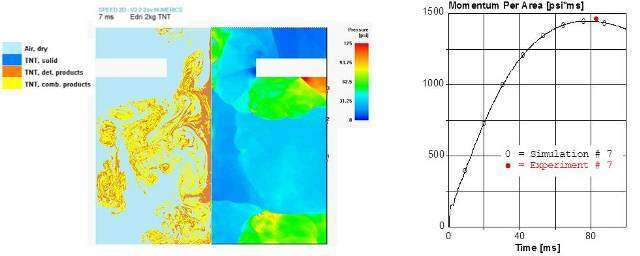It is widely known that the combustion process of the detonation products is a crucial factor for internal detonations [1]. This is true not only for blast enhanced explosives, which can be characterized as a composition of a high explosive and metal powder, but also for conventional CHNO explosives like TNT, RDX, HMX, or PETN.
During the last several years, a lot of internal detonation trials have been conducted with metallized and conventional explosives. The experimental results suggested that combustion does not only depend on chemistry, but on a lot of additional parameters, like the position of the charge within the detonation chamber and on the casing or confinement of the charge itself.
Despite its importance for internal detonations, many commercially available hydrocodes do not offer the possibility to simulate the combustion of detonation products in air. Therefore, a thermodynamic model of combustion was developed and implemented in the hydrocode SPEED. The requirement was to simulate the propagation of the detonation shock and to model the reaction of the expanding detonation products with the surrounding atmosphere.
The combustion model is capable of describing explosives whose detonation products react so fast that their combustion is controlled by mixing with the surrounding air. Particularly it is assumed that reaction of detonation products with air takes place instantaneously wherever these materials occupy the same computational cell. In addition, if metallic additives are present in the explosive, it is assumed that they are oxidized during anaerobic expansion.

Figure 1: Simulation of partially confined detonation [2]: material distribution and pressure (left) comparison of simulation and experiment (right).
In the present paper, a description of the thermodynamic model is given and the capabilities of the model are demonstrated by simulating the partially confined internal detonation tests conducted by Edri et al. [2]. Simulation results are compared to experimental records of pressure and impulse (see e.g. Figure 1). In addition, the model is applied to a fully confined internal detonation, a mine blast simulation and to a free field detonation. Whereas the combustion contributes the lion’s share to the quasi-static pressure of an internal detonation, there are only subtle effects in the case of mine blast and free field detonation.
References
[1] W. Arnold, and E. Rottenkolber, “Thermobaric Charges: Modelling and Testing”, Proceedings of the 38th International Conference of ICT, Karlsruhe, Germany, 2007
[2] I. Edri, Z. Savir, V. Feldgun, Y. Karinski, D. Yankelevsky, “On Blast Pressure Distribution Due to a Partially Confined Explosion: I. Experimental Studies”, International Journal of Protective Structures, Vol. 2, No. 1, 2011

